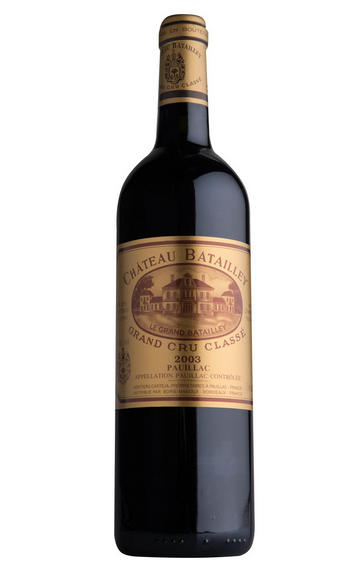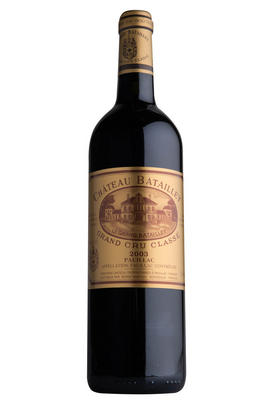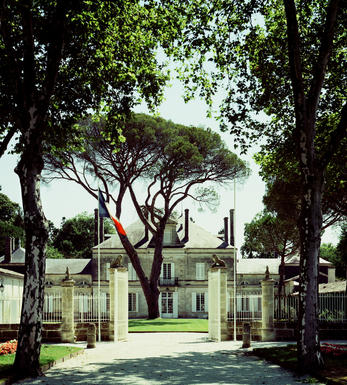
2017 Château Batailley, Pauillac, Bordeaux

Critics reviews
The 2017 Batailley has a perfumed bouquet, quite floral for this property, with violets infusing the vivacious red berry fruit. The palate is a little chewy on the entry, but it pulls through nicely towards a cohesive, dense finish. It feels primal, more so than its peers at the moment. Hopefully, it will develop more personality with bottle age...I think it will.
Drink 2023 - 2045
Neal Martin, Vinous.com (January 2020)
Filled with Pauillac signature of method and cassis on the nose, this feels polished and textured, layered with liquorice and coffee beans, with smoked, burnished oak flavours that help elongate the palate. Batailley is invariably an extremely drinkable Pauillac that delivers over the medium to long term, and this is an enjoyable and approachable wine in 2017.
Drink 2023 - 2048
Jane Anson, Decanter.com (November 2019)
Tasted blind. Deep ruby colour. Exotic spices from plush and toasty oak on the nose. This plush, rounded fruit continues on the palate, but there is a graphite edge that is savoury and moreish. Very structured with sandy, arresting tannins, it will need patience before it reaches balance.
Drink 2027 - 2037
Tom Parker MW, JancisRobinson.com (October 2021)
Medium to deep garnet-purple coloured, the 2017 Batailley gallops out of the gates with notes of baked redcurrants, black raspberries and blackcurrant pastilles plus wafts of cedar chest, bay leaves and rosehip tea. Medium-bodied, the palate delivers mouth-coating black fruits with a firm, grainy texture and lively lift to the finish.
Drink 2021 - 2037
Lisa Perrotti-Brown, Wine Advocate (March 2020)
This is straight and transparent with currant and dark-chocolate aromas. Orange peel, light tar and violets. Medium to full body. Gorgeous core of dark fruit and polished tannins that push out the edge of the wine, giving it a seamless texture. A blend of 80% Cabernet Sauvignon, 17% Merlot and 3% Petit Verdot. Needs two or three years to show it all.
Better after 2022
James Suckling, JamesSuckling.com (January 2020)
Brooding, dark and seductive on the nose, showing blackcurrant, fresh plums, dark cherries and graphite. Powerful and concentrated, with crunchy bright tones. Fresh, round and generous.
Drink 2023 - 2040
Georgina Hindle, Vincenzo Arnese, Andy Howard MW, Decanter.com (February 2022)
Pauillac is one of the highlights in the Médoc in 2017, and the 2017 Château Batailley has outstanding potential. Deep purple-coloured with a smoky, graphite, back fruit-driven bouquet, it’s broad, chunky and chewy on the palate. It lacks some elegance at the moment, but it’s an undeniably pleasure-bent effort.
Jeb Dunnuck, JebDunnuck.com (April 2018)
About this WINE

Château Batailley
Château Batailley is one of the oldest estates in Bordeaux, dating from the 15th century. A 5ème Cru Classé, it is known for producing wines of consistently high quality and excellent value in a classic Pauillac style.
The vineyard sits on a plateau at the southern end of Pauillac, on the site of a battle between the French and the English during the Hundred Years War – hence the name ‘Batailley’. The estate has been owned by the Borie family since 1932, and is currently in the hands of family-members Denise and Emile Castèja of the famous negociants Borie-Manoux, which also owns Ch. Lynch-Moussas, Ch. Trotte Vieille and Domaine de l’Église. Ch. Batailley, considered to be the jewel in the family crown, is now managed by son Philippe Castèja and grandson Frédéric.
For years, Ch. Batailley has enjoyed a reputation as a reliable, well-priced Pauillac. Over the last 15-20 years, however, there has been a much greater emphasis on the quality of the fruit. The result has been wines of decidedly more finesse – still in the classic Pauillac style, and still one of the best value Cru Classé at any level.
Since 2014, Batailley has produced a second wine, Lions de Batailley, using grapes from some of the younger vines; it’s lighter in style but retains the signature profile of the Grand Vin.
The 57 hectares of vineyards are planted in classic Pauillac proportions: 70% Cabernet Sauvignon, 25% Merlot, 3% Cabernet Franc and 2% Petit Verdot. The deep gravel beds are ideal for the later-ripening Cabernet Sauvignon; the clay and limestone subsoil is equally favourable to Merlot. Grapes are harvested by hand, in parcels of roughly one hectare each.
Grapes are fully de-stemmed, then fermented in stainless steel tanks. Malolactic fermentation takes place partly in tank, partly in barrel, and the wine is then aged in 225-litre barriques, 55% new, for 16-18 months before bottling.

Pauillac
Pauillac is the aristocrat of the Médoc boasting boasting 75 percent of the region’s First Growths and with Grand Cru Classés representing 84 percent of Pauillac's production.
For a small town, surrounded by so many familiar and regal names, Pauillac imparts a slightly seedy impression. There are no grand hotels or restaurants – with the honourable exception of the establishments owned by Jean-Michel Cazes – rather a small port and yacht harbour, and a dominant petrochemical plant.
Yet outside the town, , there is arguably the greatest concentration of fabulous vineyards throughout all Bordeaux, including three of the five First Growths. Bordering St Estèphe to the north and St Julien to the south, Pauillac has fine, deep gravel soils with important iron and marl deposits, and a subtle, softly-rolling landscape, cut by a series of small streams running into the Gironde. The vineyards are located on two gravel-rich plateaux, one to the northwest of the town of Pauillac and the other to the south, with the vines reaching a greater depth than anywhere else in the Médoc.
Pauillac's first growths each have their own unique characteristics; Lafite Rothschild, tucked in the northern part of Pauillac on the St Estèphe border, produces Pauillac's most aromatically complex and subtly-flavoured wine. Mouton Rothschild's vineyards lie on a well-drained gravel ridge and - with its high percentage of Cabernet Sauvignon - can produce (in its best years) Pauillac's most decadently rich, fleshy and exotic wine.
Latour, arguably Bordeaux's most consistent First Growth, is located in southern Pauillac next to St Julien. Its soil is gravel-rich with superb drainage, and Latour's vines penetrate as far as five metres into the soil. It produces perhaps the most long-lived wines of the Médoc.
Recommended Châteaux
Ch. Lafite-Rothschild, Ch. Latour, Ch. Mouton-Rothschild, Ch. Pichon-Longueville Baron, Ch. Pichon Longueville Comtesse de Lalande, Ch. Lynch-Bages, Ch. Grand-Puy-Lacoste, Ch, Pontet-Canet, Les Forts de Latour, Ch. Haut-Batailley, Ch. Batailley, Ch. Haut-Bages Libéral.

Cabernet Sauvignon Blend
Cabernet Sauvignon lends itself particularly well in blends with Merlot. This is actually the archetypal Bordeaux blend, though in different proportions in the sub-regions and sometimes topped up with Cabernet Franc, Malbec, and Petit Verdot.
In the Médoc and Graves the percentage of Cabernet Sauvignon in the blend can range from 95% (Mouton-Rothschild) to as low as 40%. It is particularly suited to the dry, warm, free- draining, gravel-rich soils and is responsible for the redolent cassis characteristics as well as the depth of colour, tannic structure and pronounced acidity of Médoc wines. However 100% Cabernet Sauvignon wines can be slightly hollow-tasting in the middle palate and Merlot with its generous, fleshy fruit flavours acts as a perfect foil by filling in this cavity.
In St-Emilion and Pomerol, the blends are Merlot dominated as Cabernet Sauvignon can struggle to ripen there - when it is included, it adds structure and body to the wine. Sassicaia is the most famous Bordeaux blend in Italy and has spawned many imitations, whereby the blend is now firmly established in the New World and particularly in California and Australia.


Buying options
Add to wishlist
Description
The 2017 is a blend of 17 percent Merlot, three percent Petit Verdot and 80 percent Cabernet Sauvignon. The nose is full of crème de cassis, with an array of coffee bean, mocha, damson and olive notes. The medium-bodied palate displays clean, ripe and firmly placed tannins with creamy mid-palate fruit. Cleansing and fresh acidity provides support, giving the fruit a lovely crunch. It has a nice, long, clean finish, with notes of pepper and spice.
Berry Bros. & Rudd
wine at a glance
Delivery and quality guarantee